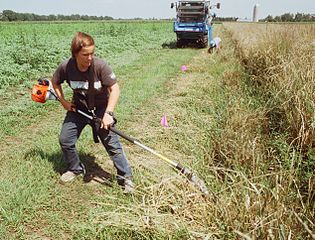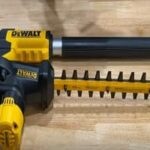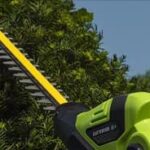As an Amazon Associate, this site earns commissions from qualifying purchases. For more information click here.
Ivy plants are generally not harmful to other plants or animals. But they spread rapidly and must be properly maintained, otherwise they will anywhere and everywhere. There are a lot of garden tools that can do this, but can you include hedge trimmers in the list? It depends on several factors and we will explain them in detail here.
Most hedge trimmers can cut ivy up to half an inch thick, but frequent use will wear out the blades quickly. If the ivy is too thick, you will have better success using a pole saw, lopping shears or pruners.
How Thick of an Ivy Plant Can Hedge Trimmers Cut?
Hedge trimmers are capable of cutting ivy, vines and branches up to an inch thick. Some models like the Stihl 56 HSA can rip through 1.6 inch branches and vines. But the average trimmer has a cutting limit of .75 to 1 inches.
If you only need to remove small ivy plants, a hedge trimmer like the Walensee 20V MAX can do the job. However there are a few things to keep in mind before you do this.
Hedge trimmers are designed mainly for trimming and managing hedges, bushes, ground cover and plants. They can cut small branches, twigs and ivy vines if small enough to fit between the blade teeth. If the vines are too thick, the blade will not be able to cut them. Forcing the blade can damage it.

There are three types of hedge trimmers: gas, corded electric and cordless battery. Gas powered trimmers are the most powerful, but this not mean they are the only ones ideal for cutting large ivy plants. The previously mentioned Stihl 56 HSA for instance, runs on a 36V battery.
There two potential problems when using a hedge trimmer to cut thick ivy: lack of power and the blades.
Even if your trimmer can cut up to 1.5 inches, some ivy plants grow much larger than that. If you are facing an overgrowth a hedge trimmer will not be sufficient and could get jammed.
The second problem is the power source. Cutting thick ivy plants and branches will consume a lot of power. The gas or battery will run out faster compared to trimming hedges. The blades will also dull much faster. You also put a lot of pressure on the engine which speeds up wear and tear.
When Should I Use Hedge Trimmers to Cut Ivy?
You should only use a hedge trimmer if the ivy plants are small and limited in number. Forcing your trimmer to cut very thick ivy plants could damage it. More so, hedge trimmers are not efficient in removing thick branches.
For 0.3 to 1 inch thick ivy plants, a hedge trimmer will do nicely. There is the gas powered Echo 2-stroke for instance, and most corded and cordless trimmers can handle up to 1 inch ivy. You can remove these small plants while maintaining your hedgerow, lawn, ground cover etc.
In these instances you won’t run into any problems. As long as you know the physical limitation of the blade and the power supply, you can keep using it.
How to Cut Ivy with a Hedge Trimmer
Now that you know the limits and capabilities of a hedge trimmer, you can go ahead and use it. First you must have the following.
You will need:
- Hedge trimmer
- Handsaw, pruning shear or lopper (the gonicc 8″ Professional pruners are a good option)
- Gloves
- Herbicide (optional)
- Water
- Safety goggles
Before you start, mark the locations where the ivy grows. It is important that you cut all of them, because if you leave one, it will grow quickly and spread.
Step 1. First you have to wear gloves and eye protection. If you are using a gas model, fill the fuel tank. If using a battery powered model, make sure it is fully charged. For corded hedge trimmers, be mindful of the cord length. Consider getting an extension cord for greater flexibility.
Step 2. Use the hedge trimmer to cut any small vines you see at the top. Depending on your trimmer, its cutting capacity might be 0.5 to 1.6 inches. For thicker vines use pruning shears, loppers or a saw.
Step 3. Look for the source of the ivy. You can do this by tracking the vines along the lines of the soil. Note the location. Check if there are other sources nearby and mark them all.
Step 4. Cut the vines off at the source. Use the trimmer, shears or whatever tool works best. You can also spray herbicide on the vines.
Step 5. Remove as much of the vines as you can. On the spot you marked as the point of origin, dampen the soil with water.
Step 6. Pull out the ivy roots. If this is not possible, apply herbicide to the roots.
Once you are done cutting, check these spots periodically. Anytime you see ivy start to reappear, repeat the process. Even if you apply herbicides, these vines can still grow.
The key here is to trim ivy vines when they are still small and thin. In this case a hedge trimmer will work fine.
Here is an example. You have just removed ivy plants in your garden but know that they can reappear. Keep an eye on the areas where they used to grow. If you spot new growth, use a hedge trimmer to get rid of them. You will not be overworking the tool since the vines are still small.
Removing ivy requires a bit more effort than cutting branches with a hedge trimmer, so it is a good idea to have other tools handy. The best ones to have are loppers, pruning shears and saws. You can use pole saws, reciprocating saws or hand saws.
Tips for Removing Ivy on Trees, Walls and Hedges
Start by cutting the ivy at the foot of the tree, then move up to your shoulder level and cut there. Always wear gloves if you are going to use your hands to discard the material you cut. Make sure you do not cut into the bark as you do this. You can use this same technique to remove ivy vines on hedges and walls.
The newer the vine, the thinner it is. As the vine gets older the thicker it can get. Some old ivy plants can be as thick as a man’s arm. For those situations you have to use a saw. Newly grown vines on the other hand, are no thicker than a flower stem. You can use a hedge trimmer or snap it with your hand.
In most cases a pair of cutting shears will do. If there are really thick vines, get a hand saw. Between these two you should be able to get the job done. But you can still use a hedge trimmer to cut thin vines.
If you are removing ivy on trees, take care not to cut the tree itself. This will cause serious harm to the tree and make things worse.
How to Remove Ivy on the Ground
Examine the ivy to be cut. If they cover large areas of your property, cut them into sections and work on one at a time.
When you have separated them into smaller parts, go through the vines. Use a trimmer, saw, shears or another cutting tool. Pull the vines once you have cut them.
Once the vines are removed, you can use pesticides or herbicides to kill off the rest of the ivy. You have to be careful though if you have plants growing nearby.
If you are going to use a hedge trimmer for this, you have to make sure its specs are up to the task. The two most important features are the blades and the power.
The blade cutting capacity determines how much of the tool you can use. If it can cut only through 0.5 inch vines, you might have to use shears or loppers instead. But if the blades have more power, you can use it in combination with your other pruning tools.

I love the outdoors and all the tools for maintaining gardens, yards and lawns. The only thing I am more passionate about is sharing what I know about garden and outdoor equipment.


